CORNEOTHERAPY
A progressive concept of self-care, a recognised scientific trend
What is corneotherapy?
Corneotherapy is the science behind the health of the skin’s stratum corneum, which aims to restore, strengthen and support the stratum corneum’s structural barrier. The founder of this science in the 70s was the American scientist and dermatologist Albert Kligman. At the beginning of this century, when instrumental methods for diagnosing sensitive skin first appeared, Kligman’s hypotheses were proven by scientists from different countries via several clinical studies. To date, corneotherapy, based on evidence, proves that the skin’s health and beauty depends entirely on the stratum corneum’s integrity. I.e. the majority of cosmetic skin problems (dryness, redness, pigmentation, inflammation, premature ageing and many others) are not independent problems or diseases, but are consequences of damage to the stratum corneum’s integrity.
The scientific basis or anatomy of protection
The skin is an external organ that comes into contact with the external environment and constantly experiences all possible temperatures, mechanisms and chemicals. The skin is made up of three layers: the epidermis, the dermis and the hypodermic. The epidermis is separated from the dermis by the basement membrane, which is made up of germ cells that constantly divide and create identical keratinocytes, which break away from the basement membrane and go down their own path of development before dying. In the process of their growth and movement towards the skin’s surface they change their external appearance, so in the epidermis there are five distinguishable layers (see fig.) although they are the same cells, but at different periods in their development. Having reached the surface of the skin, the keratinocytes lose their nucleus and turn into a flat, solid and strong flake, filled with keratin granules, this happens in the stratum corneum. Besides the keratinocytes in the epidermis there are also melanocytes, which not only give the skin its pigment but also help protectthe skin from UV and Langerhans cells, which determine the skin’s immune response.

As an organ, the skin fulfils different functions: thermoregulation, secretion, receptor functions, gas exchange, making vitamin D, and although the aesthetic function of the skin is important, its basic function is to protect, which is why it is presented in different layers by different mechanisms.
The first layer of protection is on the skin’s surface, formed by a mixture of sebum, sweat and waste products from the epidermis’s microbiome. The first layer of protection protects us from the harmful external effects of physical and chemical factors. The surface of normal, healthy skin has an acidic environment and a pH level of 5.5. This acidity negatively affects the majority of microorganisms and so it protects us from the reproduction of most of the microorganisms that surround us.
The second layer of protection is the skin’s lipid barrier which is located in the stratum corneum) which is similar to a brick wall, where the role of the bricks is played by the flakes of the stratum corneum, and the protective lipid layer – the intercellular matrix – is similar to the cement, which glues the bricks together. The lipid barrier, like the first protective layer, also protects the skin from aggressive external factors, but, more importantly, this layer protects the skin from losing internal moisture, i.e. doesn’t allow it to evaporate. This protective layer is the main one. Any damage to the second protection layer leads to the skin becoming sensitive.
The stratum corneum’s protective lipids are not linked with the work of the sebaceous glands, and they enter the stratum corneum from the deeper layers’ keratinocytes. The quality and quantity of these lipids depends primarily on a person’s lifestyle. They are specific polar lipids – ceramides, which have hydrophilic head and hydrophobic tail. This feature causes these lipids to be in a certain order in the skin: the hydrophilic heads face outwards whereas the hydrophobic tails face inwards, creating polar bilayers. When there are many of these lipids, they form long chains – lamellae, through which harmful environmental effects cannot penetrate to deeper living skin cells and cannot damage them. In the case that there are not enough of these skin lipids, then the chain is broken and individual spherical formations are created, between which there are gaps in protection. Now the aggressive external influences can penetrate deeper and the internal moisture constantly evaporates.
The lack of membrane lipids in the stratum corneum leads to a violation of the protection’s integrity and determines the appearance of sensitive skin.

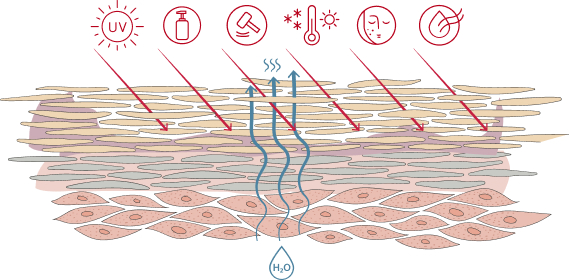
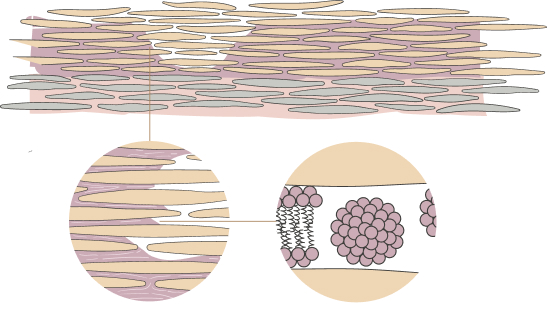
Sensitive skin
Sensitive skin or polar lipid deficiency is not a dermatological disease, but it is still an unhealthy skin condition – an imbalance which can either have slight or more serious signs.
The main symptoms for a slight imbalance are dryness, a feeling of tightness in the skin after washing, itchiness and difficulty choosing suitable cosmetics. The skin can experience discomfort, redness in windy, cold weather. With a more serious imbalance of protective properties there is also pronounced and persistent hyperaemia and dry, flaky spots may appear. With long-term sensitive skin you may see obvious dehydration and the appearance of inflammation.
Excessive fat, an uneven skin tone with a diffused pigmentation, premature aging in the form of a large number of fine lines, difficulty recovering after aggressive cosmetic manipulation and lower effectiveness of cosmetic procedures can also indicate sensitive skin.
In the case of decreasing the aggressiveness of the external environment and improving your overall health, signs of sensitive skin may resolve themselves. However, if the unfortunate condition lasts for a long time, then it can become a predisposing factor for dermatological diseases.
Variants of development of hypersensitivity in different skin types
In the case of normal skin, the ratio is balanced between the surface lipids of the first and second protective layers. There isn’t any sensitivity.
Dry, sensitive skin. In the case of a sebum deficiency, the first protective layer is already weakened and the membrane lipids of the second protective layer are more easily destroyed by external causes. The higher the level of aggressive exposure, the quicker and stronger the signs of sensitive skin will appear.

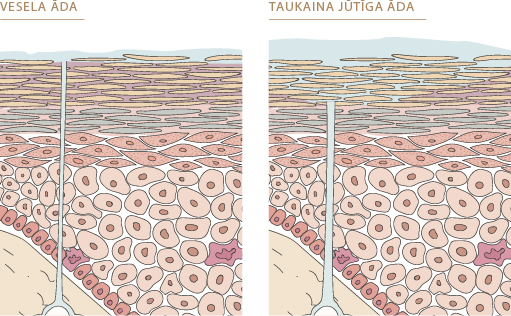
Oily sensitive skin. An excess of sebum can also lead to hypersensitivity. Sebum, which is produced excessively by the sebaceous glands is located not only on the skin’s surface, but also penetrates into the stratum corneum where is combines with the lipids of the second protective layer and destroys membrane lipids. Excessive fat, enlarged pores and dehydration help in the diagnosis of oily sensitive skin.
Cosmetic production. Emulsions and emulsifiers
The cosmetics that are now widely available on the market are made with old technology. The mass production of creams appeared about 100 years ago. At that time the notion of a cosmetic cream as a product consisted of a neutral base or base cream (90-99%) to which active ingredients (0.5-10%) are added. At the same time the emphasis of using the cream focused on the presence of certain active ingredients.
Direct and inverse emulsions
The base of the cream, from the chemical point of view, is an emulsion, e.g. oil and water which combine via an emulsifier which makes the emulsion stable and combined. There are direct and inverse emulsions. If the emulsion is predominantly oil, then the emulsion is called inverse, and the cream, as a rule, has a high fat content. The emulsifiers that are used in it are rather physiological and not harmful for the skin lipids. But, over the past 30 years there has been a demand for “light” creams, and direct emulsions have appeared on the market – creams which have a light consistency, are easily and quickly absorbed that are water-based. And in order to support the stability of such emulsions more aggressive and non-physiological emulsions are needed.
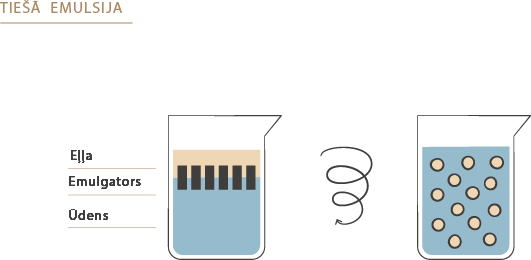
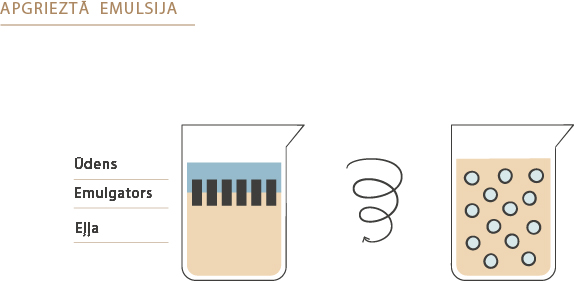
These emulsifiers, when used for a long period of time, destroy the protective lipid layer and can cause hypersensitivity in the skin.
In addition to this, there are a large number of other important technical components in cosmetics – these are stabilisers, preservatives, dyes and fragrances, which can also have a negative effect on the skin and body if a certain concentration is exceeded. Therefore, many cosmetic products do not help to solve skin problems but cause additionally aggressive even though they have valuable active ingredients.
Lamellar emulsion
Modern cosmetic products must be presented by a new type of emulsion – these are the so-called lamellar emulsions. Their unique structure is determined by the use of special, plant-based ingredients and special production technology. But for the user the most important advantage of a lamellar emulsion is the special dermatological properties. Because membrane lipids that are similar to the protective lipids of the stratum corneum are used as an emulsifier, these emulsions are as skin-friendly as possible and can be used even on sensitive, damaged skin.
In these emulsions, drops of oil are surrounded by a water-oil phase, which is in the form of lipid-fat-crystalline layers separated by water. Because there are many layers, the emulsion is called a multilamellar emulsion (MLE).
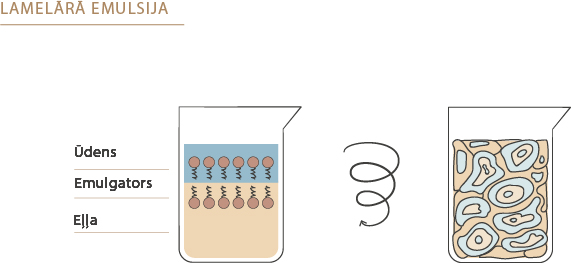
When they are on the skin’s surface, the lamellar emulsion’s lipids restore and strengthen the skin’s protective barrier. These emulsions, even if they do not have any active ingredients, have a beneficial corneotherapeutic effect, healing the skin, strengthening the protective barrier and stimulating the skin’s self-regulation process.
The base of the emulsions from Response by Dr. Stavro have a balanced composition of valuable vegetable oil from olive trees, macadamia oil, Inca-Inchi oil, shea butter, have a high percentage of ceramides and are enriched with the most valuable immunomodulator B-glucan. This composition makes this cosmetic 100% active, maintaining the physiology of its effect.
More about corneotherapy


